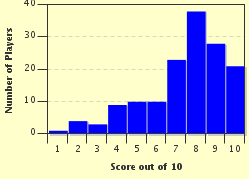Quiz Answer Key and Fun Facts
1. Ho Chi Minh was born in 1890 in Vietnam. His father was a scholar, teacher and a magistrate who found himself in disgrace by causing the death of a powerful figure in their town. How did he do this?
2. Ho Chi Minh initially began work as a teacher. By 1912 however, he was working as an assistant cook on a ship that was heading towards a country that would later play an enormous role in Vietnam. Which country was this?
3. Ho Chi Minh also moved to England and back during his time in the United States. From 1919, however, he moved to France, where he lived until 1923. By now he was calling himself Nguyen Ai Quoc. An ominous pointer to what would later happen in Vietnam, what is the English translation of that name?
4. Vietnam at this time in Ho Chi Minh's life was still known by which name?
5. At the end of 1923, Ho Chi Minh moved from Paris to take up residence in Moscow. From there, in order to fine tune his communist training, he soon relocated to which country?
6. Ho Chi Minh had to quickly flee from China in 1927. Why?
7. It seemed indeed that Ho Chi Minh's communist career was over. On his release by the British in 1933, he moved to Italy and worked quietly as a waiter in a restaurant there. Not so. Back to Russia he soon went and stayed there until 1938 - and from there back to China where he changed his name again. In what year did he begin to call himself Ho Chi Minh?
8. In 1941, Ho Chi Minh returned at last to Vietnam and took over as the leader of the Vietnamese independence push there. This became known as the "Viet Minh" movement. During the war years this force had to now battle the Vichy French and the Japanese, both of whom were now occupying Indochina. Which country secretly aided the Viet Minh in this struggle?
9. In 1945, when the Japanese surrended to the Allies, this allowed the Vietnamese nationalist groups, led by Ho Chi Minh, to take over the cities there. They immediately commenced setting up an independent Vietnamese government. What happened to all the French officials there at that time?
10. In September 1945, only a few days after Ho Chi Minh declared the foundation of the Democratic Republic of Vietnam, the Chinese nationalist forces took control of Vietnam north of the 16th parallel. Which country took possession of the country south of the 16th parallel?
Source: Author
Creedy
This quiz was reviewed by FunTrivia editor
stedman before going online.
Any errors found in FunTrivia content are routinely corrected through our feedback system.


